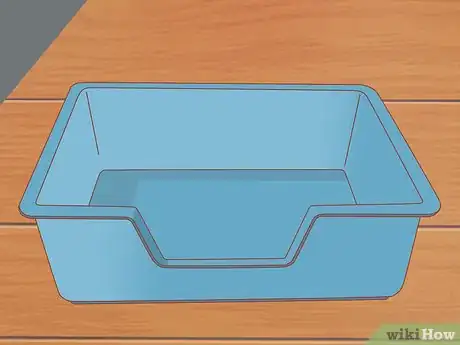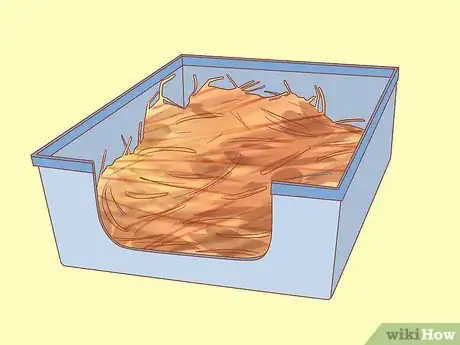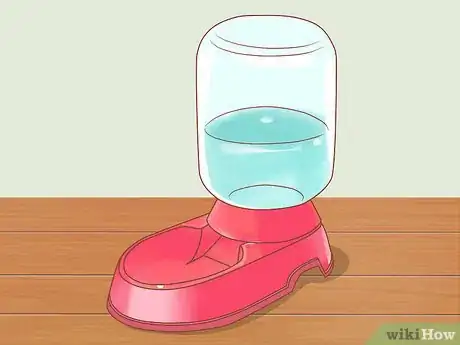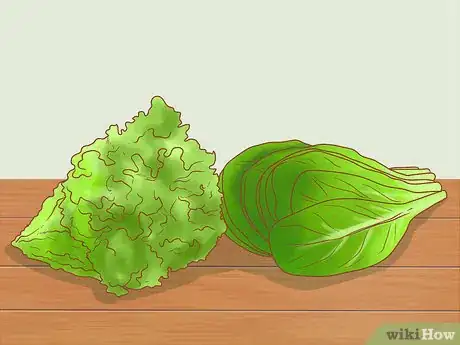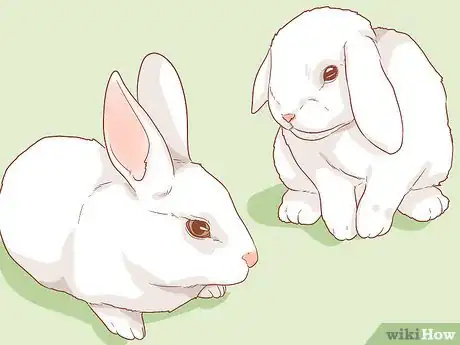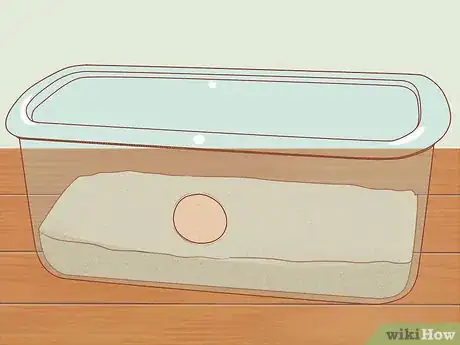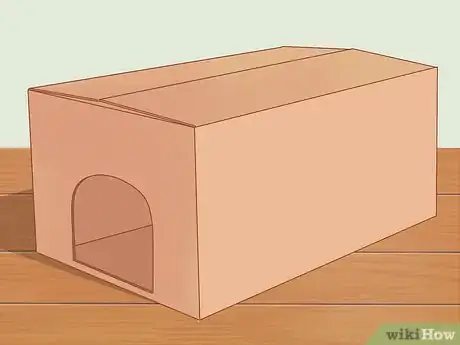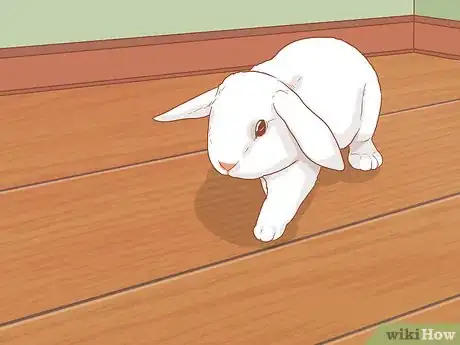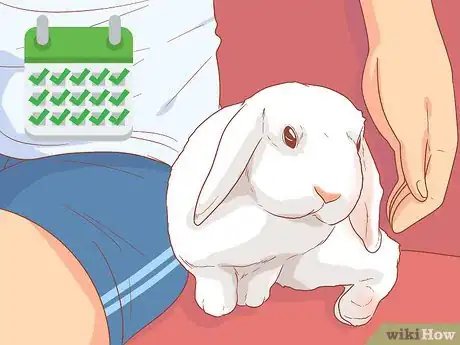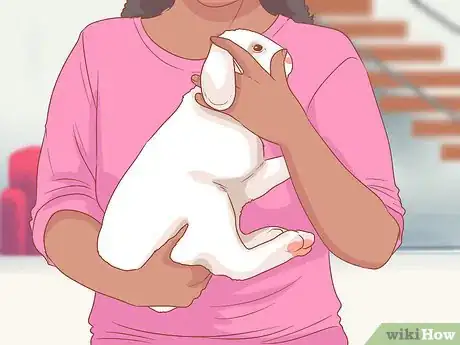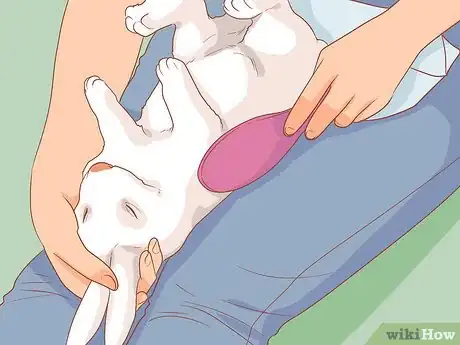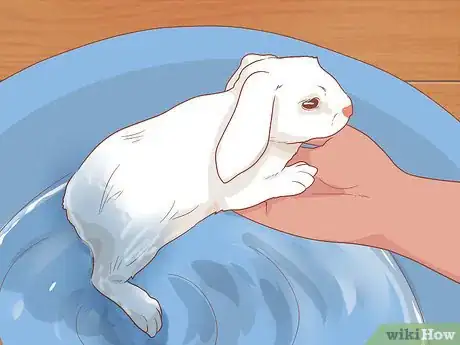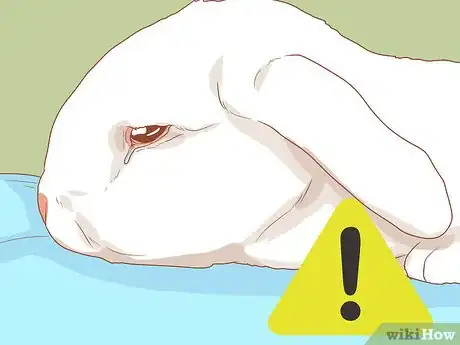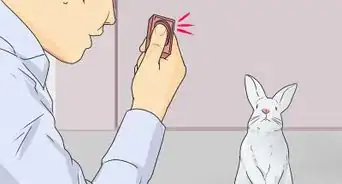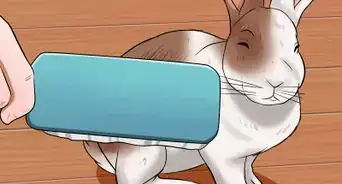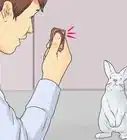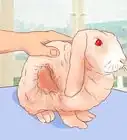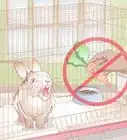This article was co-authored by Pippa Elliott, MRCVS. Dr. Elliott, BVMS, MRCVS is a veterinarian with over 30 years of experience in veterinary surgery and companion animal practice. She graduated from the University of Glasgow in 1987 with a degree in veterinary medicine and surgery. She has worked at the same animal clinic in her hometown for over 20 years.
There are 16 references cited in this article, which can be found at the bottom of the page.
wikiHow marks an article as reader-approved once it receives enough positive feedback. This article received 21 testimonials and 82% of readers who voted found it helpful, earning it our reader-approved status.
This article has been viewed 708,919 times.
Lop-eared rabbits have to be raised properly, like any other pet. Rabbits need plenty of care as well as a good and safe environment if they are to be healthy and happy. They are sociable animals who like the company of other rabbits so it is often recommended that you should get more than one rabbit. If you give your rabbits everything they need, they will happily hop around your house.
Rabbits must be spayed/neutered prior to introducing them to one another, and bonding them takes time and patience. There are many different approaches to bonding, but they should not be just put together and left alone, they can seriously injure one another.
Steps
Housing Your Rabbit
-
1Consider carefully before purchasing a rabbit. It can be tempting to impulsively buy lop-eared rabbits because of their adorable looks, but consider if this is the right pet for you before you purchase it. Any rabbit whose ears lop down the side of his head, rather than pointing up, is a lop. There are around 19 different breeds of lops, each with different sizes and characteristics.
- English lops and Miniature lops (known as Holland lops in the US) are popular as pets.
- Contact a local breeder, animal rescue centre, or pet shop.
- Rabbits live for around nine to eleven years, and require attention and care for all of these years. They are active and need space to run around.
-
2Know the costs. Before you go ahead and get a rabbit you need to be sure that you can afford to keep it. The price of a lop can vary, but you should expect to pay somewhere between $15 and $60.[1] As well as buying the rabbit you will need to spend approximately $90 for a cage, $30 for a carrier and $25 for a litter box. This is just to get you started.
- You should expect to have an average food bill of around $800 a year, and factor in $300 for toys and treats on top of that.
- After this add on $125 for a basic veterinary checkup with a rabbit-savvy vet, but keep in mind that rabbit veterinary medicine is a specialized field, and most vets do not know how to properly treat rabbits. It's crucial to have your rabbit spayed/neutered if s/he isn't already when you adopt him/her, and this often costs around $300. Illness or injury can run from $500 up into the thousands. Be prepared in case your rabbit becomes ill; the first sign of symptoms means it's an emergency as rabbits hide signs of illness until they are crucially ill.
- Don't forget $400 a year for litter.[2]
Advertisement -
3Get a good size exercise pen or rabbit condo, or plan to bunny-proof your entire home so your rabbit(s) can be free roam. Rabbits are small creatures, but they are very active with strong and powerful hind legs that are designed for running and jumping around. As such they need lots of space to move around freely. The minimum recommended exercise pen for a single rabbit of a small to medium-sized breed is four feet wide and six feet long.[3]
- Do not use a wire cage! If you must use a wire cage be sure to cover the bottom of the cage with cardboard, or a piece of wood, covered over with bedding to protect their feet. Rabbits' feet are very delicate and can become inflamed and quickly infected from standing on wire.
-
4Keep the bunny indoors. Although it is quite common for rabbits to be kept in outdoor hutches, it is now advised that you opt to house them indoors. An outdoor hutch isolates sociable creatures and exposes them to dangers of predators. Even if they secured in a hutch, a rabbit can die from a heart attack brought on by an approaching predator.[4]
- Keeping them indoors means they can interact with you and your family.
- A secure and warm environment where they can run around is highly beneficial.
-
5Get an extra large litterbox. In addition to a pen or condo if you cannot allow your rabbit to free roam, you will need to litter train your rabbit. Rabbits cannot usually be litter trained until after they are spayed/neutered. A large litterbox is important for your rabbit's hygiene.
Feeding Your Rabbit
-
1Have a constant supply of hay. Hay, and/or grass, are the most important elements in a rabbit's diet. Rabbits are grazers so it's essential that you have plenty of hay for them to nibble on throughout the day and night. A rabbit needs a good intake of grass or hay to keep their digestive system working properly.[5] You should ensure that there is fresh hay available to your rabbit at all times.
- Your rabbit will eat a bundle of hay about the same size as him every day.[6]
- Liberally spread the hay around the hutch and litter tray area. Rabbits like to eat hay while they are resting. Putting hay in these places will encourage them to eat plenty of it.[7]
- Rabbits tend to graze the most at dawn and dusk.
-
2Ensure your rabbit has continuous fresh clean water. You should check your rabbit's water supply twice and day and top up as required. If your rabbit is outdoors take care to ensure that the water doesn't freeze in cold weather. Inadequate water supplies can seriously harm the health of your rabbit.[8] You can use either a water bottle or a dish, the most important thing is the constant supply of fresh water.
- Drinking from a dish may be more natural for your rabbits, and you might find they prefer this. The down side is that water in a dish will easily become soiled with bedding.[9]
- It's a good idea to monitor how much they drink. A sudden drop off in the amount of water they drink can indicate health problems.
-
3Have a good supply of dried food. A rabbit should have a diet that combines good quality dried food (often referred to as pellets), fresh hay, oat hay, fresh vegetables and water.[10] You should follow the manufacturer's instructions for pellets, but it is advised not to just keep re-filling their bowls. If you do this the rabbits may end up not getting enough hay.
-
4Feed him fresh food. Fresh leafy greens should account for around a third of your rabbit's diet. He'll enjoy lots of different greens, including dark leaf lettuces, collard greens, turnip greens and carrot tops. The amount your rabbit will eat depends on the age and size, but as a basic guide, it is recommended to provide two cups of greens per six pounds of rabbit weight each day.[14]
- Fresh herbs are also a good choice.
- Be sure they are washed and cleaned before giving them to your rabbits.[15]
-
5Give him occasional treats. Sometimes you will want to treat your rabbit with a piece of fruit or a root vegetable. Rabbits do not eat these naturally so you should limit the amount you give them. Avoid treats other than fruit and root vegetables, as they harm your rabbit.[16] Some appropriate treats include strawberries, pineapples, apples, raspberries and pears.
- You should not give your rabbit more than two heaped tablespoons of treats per 4 pounds of body weight. Banana slices should only be given very occasionally.[17]
- Be sure you remove the pips from fruit such as apples and pears. These can be poisonous for rabbits.
- Some common plants, including egg plants, tomato plants, and potato plants can also be harmful for your rabbit.
- Do not feed your rabbit anything that contains chocolate or caffeine, bread, grapes or raisins.
Keeping Your Rabbit Happy
-
1Give him some company. Rabbits should be kept with at least one other friendly rabbit. They are sociable animals and like to be with other rabbits. A good combination is a neutered male and neutered female of the same size and breed. If rabbits are left alone for long periods they can develop abnormal behaviours.[18]
- Allow your Lop to choose its own companion, if possible. Some rescue organizations may allow you to introduce your rabbit to other rabbits before adopting.
- For a bonding session you need to put two rabbits together in a neutral space with toys and treats to make it an enjoyable time. Watch over them and see how they get along.[19]
-
2Have a good supply of toys and things to chew. You should supply an abundant amount of safe and chewable toys for your rabbit. Some safe chew toys include simple things like cardboard boxes, or even an old telephone directory.[20] You could also give them an old cotton towel to chew on, as long as you don't mind it getting chewed to bits.[21]
-
3Give your rabbit places to dig. As well as being chewers, rabbits are diggers. It's in their nature to dig, so it's important to give them opportunities to do it. They won't be digging holes in your floor like they would outside in the wild, but you can simulate it with a digging box. You can put together a digging box simply getting a good size cardboard box and filling up halfway with shredded paper.[22]
- If you don't mind the mess, you could even put soil in the box.
-
4Provide a place to hide. It's very important to provide places where your rabbits can hide. They do this if they are feeling afraid and it's nothing to worry about. They need to be able to hide when something scares them or they will become stressed. The hiding places should have two entrances/exits and be high enough for them to run underneath.[23]
- Have at least one hiding place per rabbit.
- If you have more than one rabbit also provide a place big enough for them to hide together.
- As a prey species they need to be able to hide somewhere away from the sight and smell of predators.
- Even if they are totally secure in your house, you still need to provide hiding places.
-
5Allow him time and space to run around. You should take your rabbit out of its cage every day so he can run around and get some exercise. Rabbits are very active animals which need frequent exercise ideally in a large space. They are most active early morning, late afternoon and overnight when they like to forage, graze and socialise.[24]
- It's important to rabbit proof your home so that he is safe before you do this.
- Rabbits should be able to exercise for several hours a day.[25]
-
6Sit with your rabbit daily. Rabbits are sociable creatures so it's important that spend some time with them. Interact with them regularly to help you bond. Try to put some time aside every day to be with them, even if this is just sitting in the same room while he is roaming about. If you are watching TV you might find him climb onto the sofa to say hello.
-
7Know how to handle your rabbit. Rabbits need to be handled carefully and with sensitivity. Move slowly and talk quietly around him and lower yourself down to floor level. If he is comfortable with being handled you can slide one hand underneath his rib cage and gently lift him while you scoop up his rear with the other hand. Slowly lift him up to your chest and hold him gently but firmly, with one hand supporting his hindquarters at all times. You can help him feel secure by holding all four of his feet against your body.[26]
- It's best to start handling you rabbit at a young age so they get used to the contact. If you have a rescue rabbit who is not used to being handled they might find it distressing.
- Never pick up a rabbit by its ears, and ensure that children are supervised when around your rabbit.
Maintaining Health and Hygiene
-
1Clean out the cage and litter box. You should regularly clean out your rabbit's housing and its litter tray. It's important to provide a well-kept and clean environment for them to live in. You can empty out and replace soiled bedding every day and it won't take long. Give the cage a more thorough clean once a week.
- Once a month, or every two weeks if needed, you should completely clean out the cage, scrubbing it throughout and letting it dry.
- Only put the rabbits back in once the cage is completely dry.
-
2Groom your rabbit. It's good to regularly brush your rabbit with a soft brush to remove any excess hair. Moulting hair can build up in mats and cause sores to develop if you don't groom him sufficiently. Brushing will generally help to keep his coat in top condition. When you are brushing go from the back of the head down to the tail.
- Be gentle and patient with your rabbit. Different rabbits will respond to being brushed in different ways.[27]
- You can also clip your rabbit's nails, but you should speak to your vet before attempting this.
-
3Bathe your rabbit only when necessary. Bathing should only be done if your rabbit is very dirty and is unable to clean himself. Use shampoo designed for washing rabbits. Make sure he has secure footing at the bottom of the bowl, and the water is warm. The biggest risk would be him taking fright, jumping out of the bowl or bath, and injuring himself.
- You can also spot clean him by sprinkling a little baby cornstarch onto his fur and working it through with a fine flea comb.[28]
- Instead of dipping him in water, try dampening a cloth with warm water and moistening the fur, trying not to let the skin get wet.
- Dry him off with a hair dryer set to the lowest setting always being gentle and sensitive.[29]
-
4Know when to take him to the vet. It's recommended that you bring your rabbit to your local vets for a check-up at least once a year. In between these times you can help by observing your rabbit and watching out for any signs of ill health. If you think he might be ill make an appointment with the vet as soon as possible. Symptoms to look out for include:
- Your rabbit stopping eating.
- Your rabbit not having a bowl movement for twelve hours or longer.
- Watery diarrhoea.
- Runny nose and eyes.
- Dark red urine.
- Fur loss, or red and swollen skin.
- Lethargy.[30]
Expert Q&A
Did you know you can get expert answers for this article?
Unlock expert answers by supporting wikiHow
-
QuestionAre Lops more likely to get ear infections than other rabbits?
 Pippa Elliott, MRCVSDr. Elliott, BVMS, MRCVS is a veterinarian with over 30 years of experience in veterinary surgery and companion animal practice. She graduated from the University of Glasgow in 1987 with a degree in veterinary medicine and surgery. She has worked at the same animal clinic in her hometown for over 20 years.
Pippa Elliott, MRCVSDr. Elliott, BVMS, MRCVS is a veterinarian with over 30 years of experience in veterinary surgery and companion animal practice. She graduated from the University of Glasgow in 1987 with a degree in veterinary medicine and surgery. She has worked at the same animal clinic in her hometown for over 20 years.
Veterinarian No, not necessarily. Because the Lop ear reduces the air circulation in the ear canal, you might expect them to get more infections, but this doesn't seem to be the case. This is probably because rabbits have nice, wide ear canals which allow a good circulation of air, which makes it a more hostile place for bacteria to live.
No, not necessarily. Because the Lop ear reduces the air circulation in the ear canal, you might expect them to get more infections, but this doesn't seem to be the case. This is probably because rabbits have nice, wide ear canals which allow a good circulation of air, which makes it a more hostile place for bacteria to live. -
QuestionAt what age should I start litter box training my rabbit?
 Pippa Elliott, MRCVSDr. Elliott, BVMS, MRCVS is a veterinarian with over 30 years of experience in veterinary surgery and companion animal practice. She graduated from the University of Glasgow in 1987 with a degree in veterinary medicine and surgery. She has worked at the same animal clinic in her hometown for over 20 years.
Pippa Elliott, MRCVSDr. Elliott, BVMS, MRCVS is a veterinarian with over 30 years of experience in veterinary surgery and companion animal practice. She graduated from the University of Glasgow in 1987 with a degree in veterinary medicine and surgery. She has worked at the same animal clinic in her hometown for over 20 years.
Veterinarian
Warnings
- Do not ever feed your rabbit human food or foods dangerous for rabbits. Rabbits have a very delicate digestive tract, and they will become ill and die easily. Feed only what is in their approved diet.⧼thumbs_response⧽
- If your rabbit is sick, take it to the vet immediately! Rabbits are prey animals and tend to hide their sicknesses; if you've spotted a problem, it can be very serious.⧼thumbs_response⧽
- If you take your rabbit outdoors, be sure to supervise it.⧼thumbs_response⧽
- Rabbits love to chew. Give them things to chew (non-toxic wood blocks, cardboard, etc.), but be sure to completely "rabbit-proof" the area they will be allowed to roam.⧼thumbs_response⧽
- Human food (processed) is not rabbit food.⧼thumbs_response⧽
- Always support the back legs of a rabbit; if you do not do this, if they kick out they can cause serious damage to their back.⧼thumbs_response⧽
Things You'll Need
- Pellets for rabbits
- Fresh food for rabbits
- Fresh clean water
- Water and food containers
- Hay and a hay holder
- Litter boxes
- A large cage with a solid floor
- A bunny-proof area for the rabbit to exercise in
- Toys
- A box or other space for them to hide in
- A dog brush for long haired rabbits
References
- ↑ http://pets.costhelper.com/pet-rabbit.html
- ↑ https://www.aspca.org/pet-care/small-pet-care/general-rabbit-care
- ↑ https://www.aspca.org/pet-care/small-pet-care/general-rabbit-care
- ↑ https://www.aspca.org/pet-care/small-pet-care/general-rabbit-care
- ↑ http://www.rspca.org.uk/adviceandwelfare/pets/rabbits/diet
- ↑ http://www.rspca.org.uk/adviceandwelfare/pets/rabbits/diet/planner
- ↑ http://www.therabbithouse.com/blog/2007/06/20/5-ways-to-get-your-to-rabbit-eat-more-hay/
- ↑ http://www.rspca.org.uk/adviceandwelfare/pets/rabbits/diet
- ↑ http://www.therabbithouse.com/equipment/rabbit-water.asp
- ↑ http://rabbit.org/faq-diet/
- ↑ https://www.aspca.org/pet-care/small-pet-care/general-rabbit-care
- ↑ http://www.rspca.org.uk/adviceandwelfare/pets/rabbits/diet
- ↑ https://www.aspca.org/pet-care/small-pet-care/general-rabbit-care
- ↑ https://www.aspca.org/pet-care/small-pet-care/general-rabbit-care
- ↑ http://www.rspca.org.uk/adviceandwelfare/pets/rabbits/diet
- ↑ http://www.rspca.org.uk/adviceandwelfare/pets/rabbits/diet
- ↑ http://support.michiganhumane.org/site/PageServer?pagename=vetcare_rabbits
- ↑ http://www.rspca.org.uk/adviceandwelfare/pets/rabbits/company
- ↑ http://ontariorabbits.org/behaviour/bonding
- ↑ https://www.aspca.org/pet-care/small-pet-care/general-rabbit-care
- ↑ http://rabbit.org/faq-chewing/
- ↑ https://www.aspca.org/pet-care/small-pet-care/general-rabbit-care
- ↑ http://www.rspca.org.uk/adviceandwelfare/pets/rabbits/behaviour/enrichment/hidingplaces
- ↑ http://www.rspca.org.uk/adviceandwelfare/pets/rabbits/behaviour
- ↑ https://www.aspca.org/pet-care/small-pet-care/general-rabbit-care
- ↑ http://www.rspca.org.uk/adviceandwelfare/pets/rabbits/company/handling
- ↑ https://www.aspca.org/pet-care/small-pet-care/general-rabbit-care
- ↑ http://rabbit.org/faq-grooming/
- ↑ http://www.rabbitwelfare.co.uk/pdfs/BathingBunnies-RO.pdf
- ↑ https://www.aspca.org/pet-care/small-pet-care/general-rabbit-care
About This Article
To raise a lop-eared rabbit as a pet, start by preparing a cage or hutch lined with hay, including a litter box for good hygiene. Additionally, consider getting at least two rabbits at a time, since they are social animals and can develop abnormal behaviors if left alone. Then, make sure to that your rabbit always has access to clean water and dried food. Additionally, feed your rabbit about 2 pounds of fresh greens, like collards or carrot tops, per 6 pounds of its weight each day. You can also give your rabbit things to chew on, like cardboard boxes, to keep it busy. For tips from our Veterinary co-author on how to bathe your rabbit, read on!




